
M'Hamid and the Sahara
M'Hamid and the Sahara — Toilets of Morocco
VisitingM'Hamid
M'Hamid is on the edge of the Sahara desert,
at the end of the paved highway running southeast from Marrakech.
The town's full name is M'Hamid el Ghizlane,
meaning "plain of gazelles".
But it's the most prominent M'Hamid,
and the most likely for a foreign visitor to be headed toward,
so simple "M'Hamid" is usually specific enough to explain
your plans and buy a bus ticket.
Or, for me, a seat in a shared car from Zagora.
M'Hamid is south of Zagora,
just 25 kilometers from the Algerian border.
It's the starting point for treks into the desert,
especially to Erg Chigaga which I wanted to visit.
M'Hamid is built along the
Oued Drâa
or the Draa Wadi,
Morocco's longest river.
Below is the view mid-crossing as I walked to my guesthouse.
Yes, those are camels,
and no, there is no visible water.
It's a wadi, with no visible water most of the year.
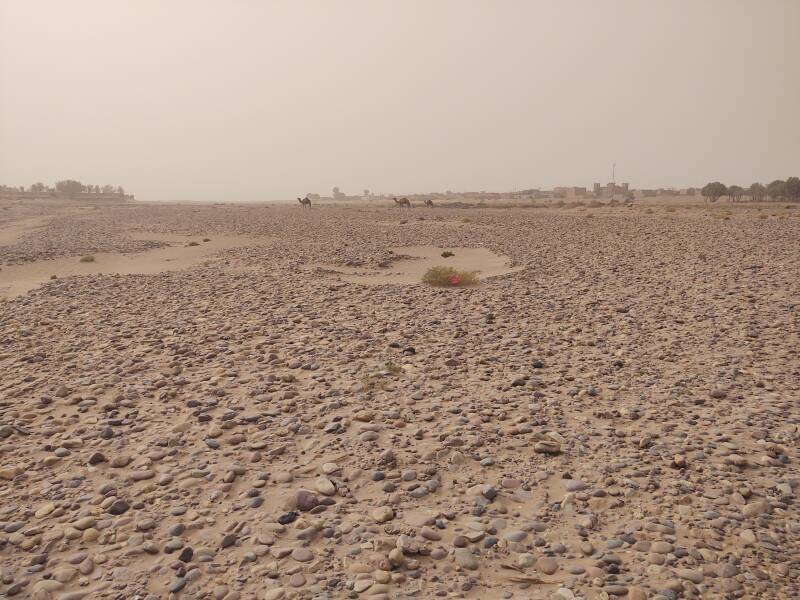
Auberge la Palmeraie in M'Hamid
Guesthouses at Booking.comI had reserved a room through booking.com at l'Auberge la Palmeraie. It was a wonderful place to relax for a few days. I could watch the cats watching the garden. It was also a good place to easily organize a trip into the Sahara.
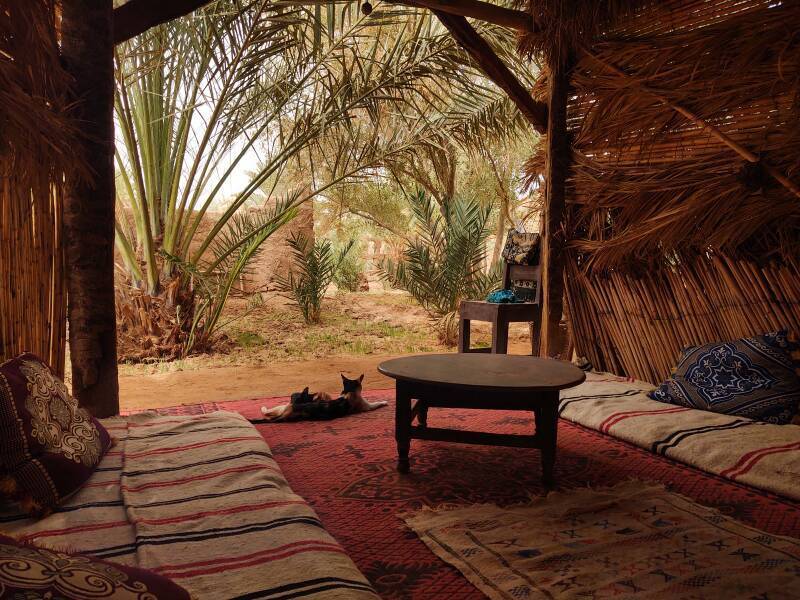
My room was the middle door along this side of the main building. Notice the water tank overhead, and the solar panels beyond it. Also notice the irrigation channel in the left foreground.
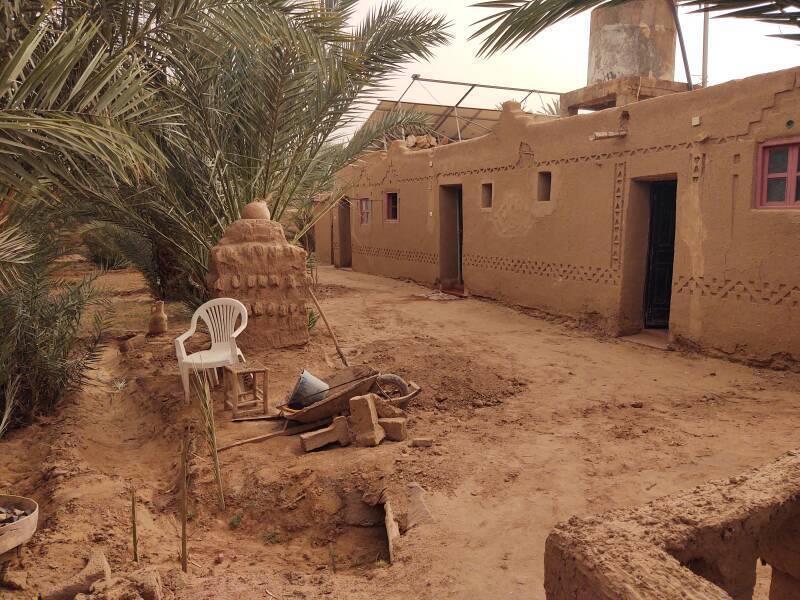
My room at Auberge la Palmeraie was just 85 Dirham per night including the added tax, about US$ 8. The window was just an opening, no glass or screen and not perfectly sealed even with the wooden shutter closed. The Draa wadi is quite dry, the entire area is arid, but still there are mosquitos at night. The mosquito net was essential. I was as deep into Berber country as you get in Morocco, so of course that's a real Berber carpet on the floor.
Booking.com had sent their usual frantic blizzard of notifications, including one telling me that I could upgrade to an en suite room here, one with its own bathroom, for just an additional US$ 2 per night.
And so I upgraded. It would have been 65 Dirham or US$ 6 per night with shared plumbing. Post-trip calculations showed that my lodging averaged US$ 17 per night for the four weeks in Morocco. The supposedly high price is due to all the optional bathrooms.
Notice my water supply in the picture. That's a 1.5-liter bottle I had brought with me in the shared car from Zagora, and a 5-liter jug I bought at a shop in the center of town as soon as I got settled in here.
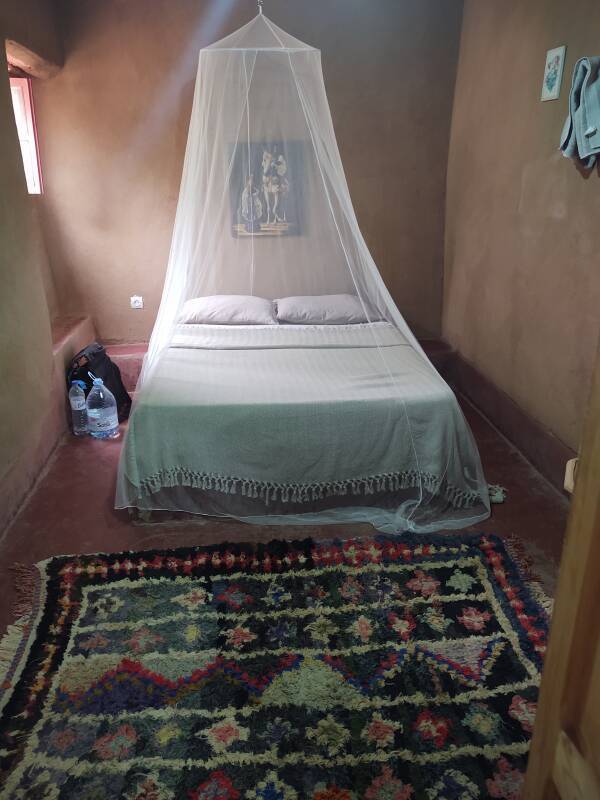
This view from beside the bed shows the shelves with my pack and the door into the bathroom.
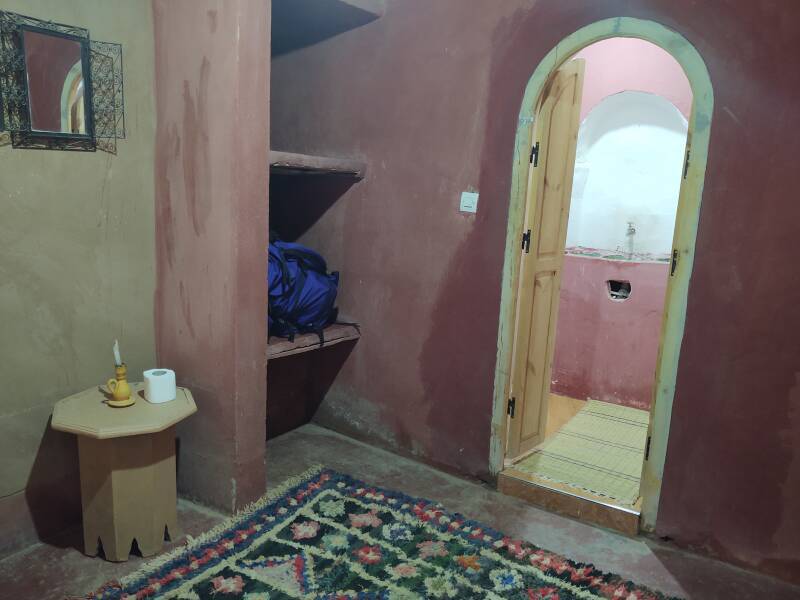
How should I clean myself, water or paper? Bowl or bin?
Where do I put used toilet paper?
Notice the two rolls of toilet paper on the tank, and the extra roll in the room in the picture above.
Also note the trash bin next to the toilet.
So, they expect that some foreign visitors will very likely want to use paper. Although, I took this picture while standing in the shower just across the room, so water is an easy alternative. And, they probably get more French-speaking and thus bidet-using visitors in this area.
I interpreted the placement of the trash bin as a signal to put my used toilet paper there.
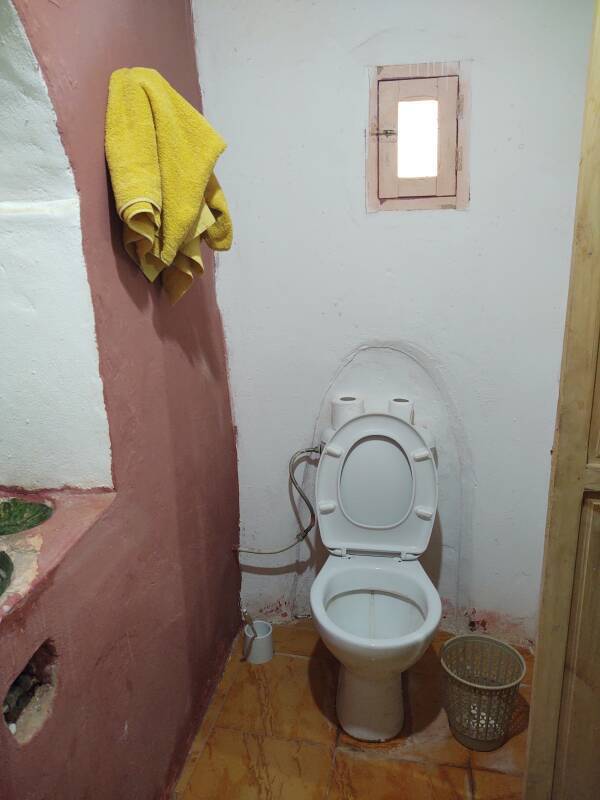
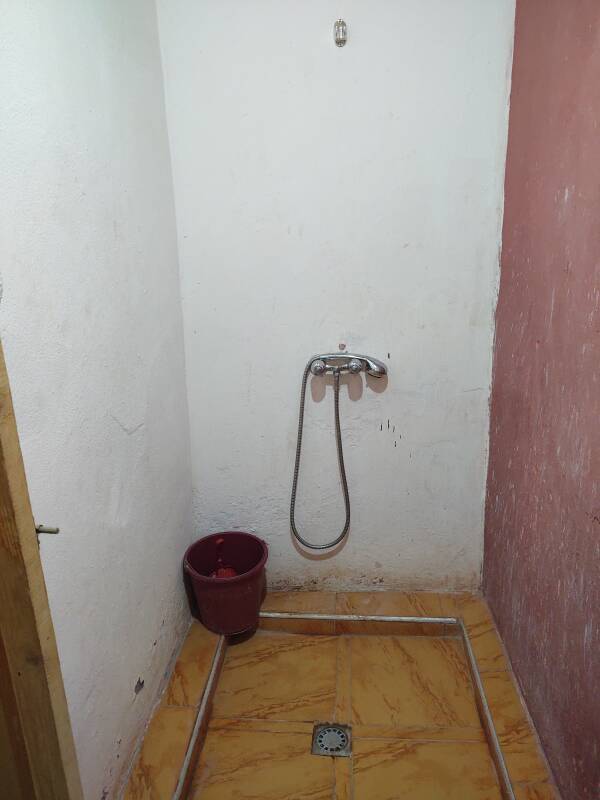
Above is the shower. That's a red plastic bucket, which you might fill with post-BM cleaning water before using the toilet.
I have no idea why the buckets are almost always red. But I do notice the pattern.
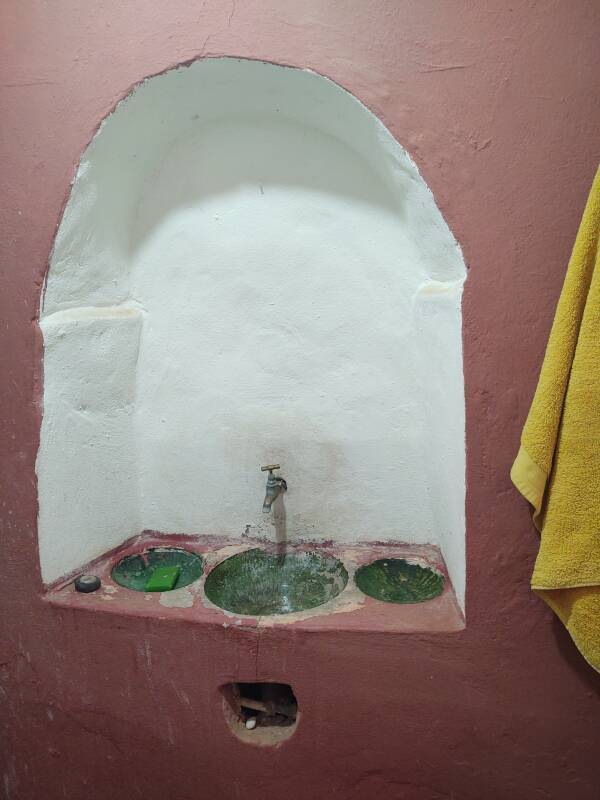
The sink was built into an alcove opposite the door from the bedroom. The small bowls to either side of it are for holding soap, they have no drains.
Back in Zagora the tap water had been a little brackish. You wouldn't want to drink much of it, but it was fine for brushing your teeth.
However, the limited groundwater remaining at M'Hamid is very salty. I'm sure that local people have become accustomed to it. But for me, the tap water was much too salty for brushing my teeth.
I had anticipated that. I bought the first of my five-liter jugs the first afternoon in M'Hamid, before I had tried brushing my teeth. All accommodations in town would have salty tap water, because everything in M'Hamid has to connect to the one salty source.
There was a grocery store back across the dry Draa bed at the center of town, with the inescapable Coca-Cola logo.
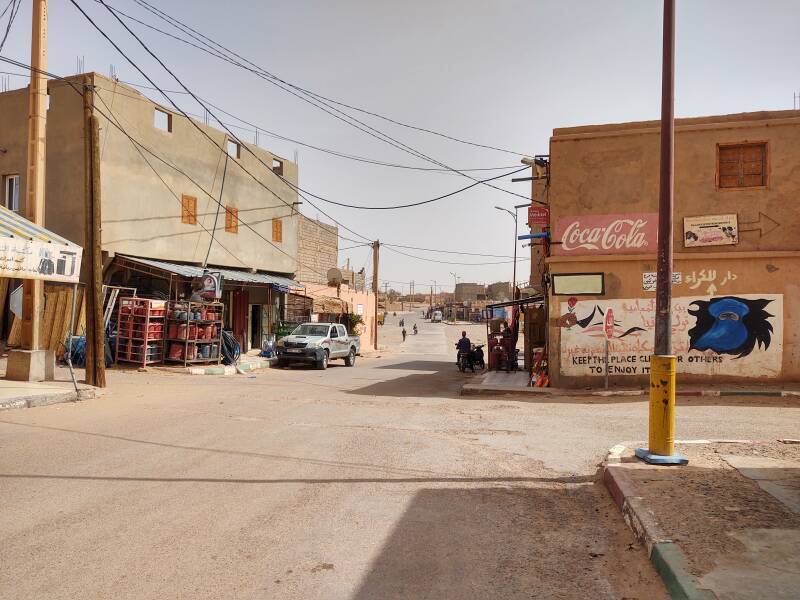
People have lived in M'Hamid for centuries. The water supply and flourishing date palm oases through earlier centuries make it likely that this area was settled around 3000 BCE, when northwestern Europe was in its Neolithic era.
However, the winter rains have been shrinking since the 1970s. By the 2010s there were winters with no rain at all. Agriculture has ended in the area, other than personal gardens irrigated with salty water pumped up from wells. On top of the drought, the fungal disease Fusarium oxysporum has attacked the date palm trees that still survive.
The ksar, the fortified town of M'Hamid, was established during the Saadian era of 1549–1659. It served as an imperial station where caravans paid taxes on goods being brought in from Timbuktu and other oases and markets across the desert.
The local population has been decreasing since the middle of the 20th century because of the decrease in the water table and the increasing salinity of what little ground water remains.
The population of the M'Hamid commune, the town and the surrounding territory, was about 8,500 at the census in 1994, about 7,800 in 2004, and a little under 6,900 in 2014.
As I explained, I had upgraded to an en suite bathroom. But I did check out and use what I would have had with the shared option. That included a choice of squat or not.
In the first picture, notice the bucket for self-cleaning water at right, and the bin for used paper at left.
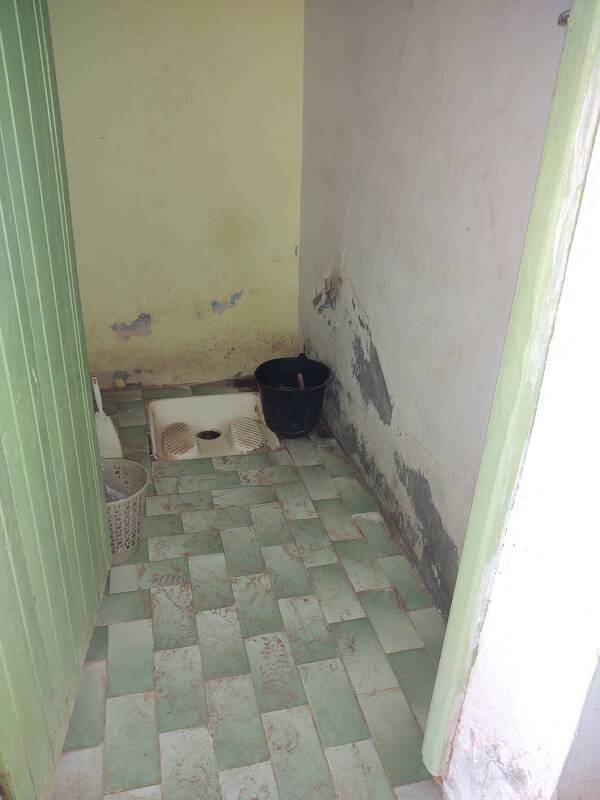
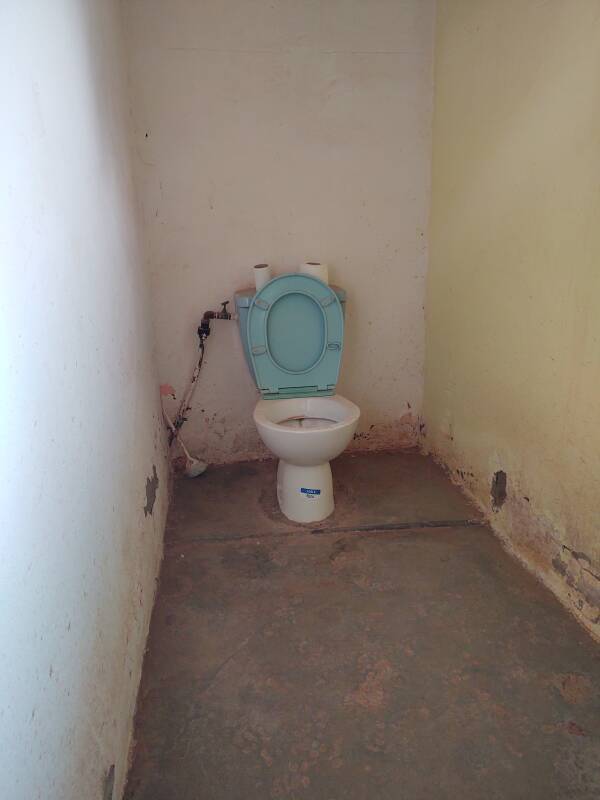
The shared raised throne commode had two rolls of toilet paper sitting on the tank, but nowhere to put the used paper other than into the bowl. I had asked my innkeeper, and he said that toilet paper could all go into the toilets.
That is, toilet paper, designed to quickly break down in water. Don't put the far more rugged facial tissue into a toilet, in Morocco or anywhere else.
Irrigation in M'Hamid
Auberge la Palmeraie had some gardens, which needed regular irrigation.
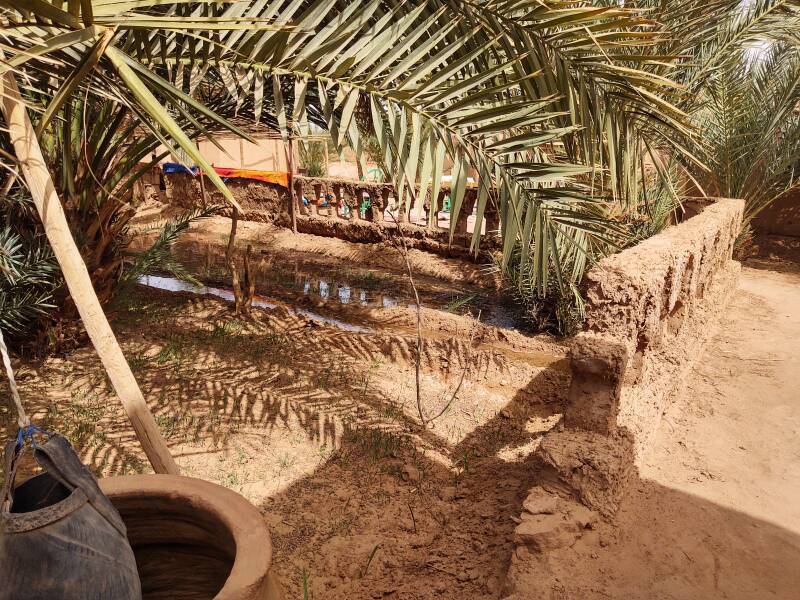
It reminded me of my cousins' place in eastern Oregon, where the farm, garden, and front yard were all watered by damming small irrigation channels.
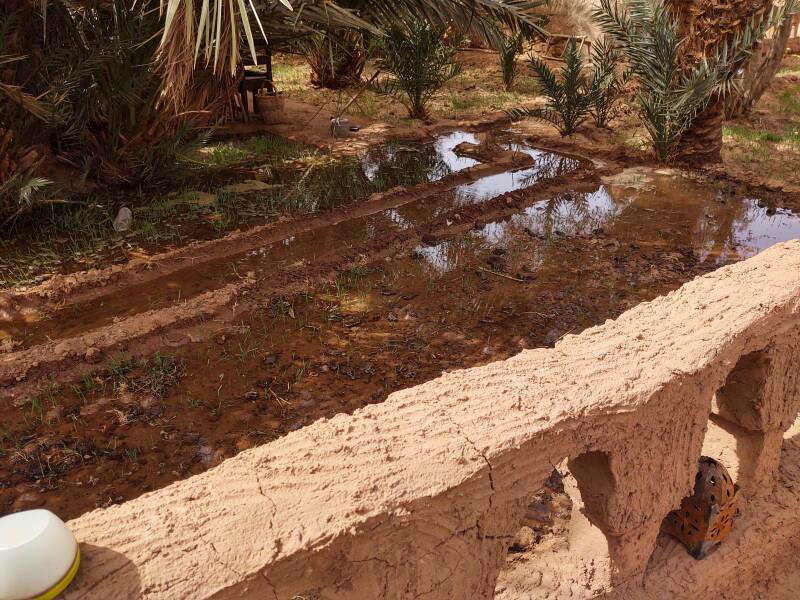
Into the Sahara
Ibrahim, my innkeeper, organized an overnight trip to Erg Chigaga, Morocco's largest Sahara dune field. We would drive there in his 4×4, it's about a 60 kilometer route.
There is a tree in this picture. It's the tiny smudge on the horizon about 60% of the way from left to right, about one kilometer away. Otherwise there's nothing to see here but sand and small rocks.
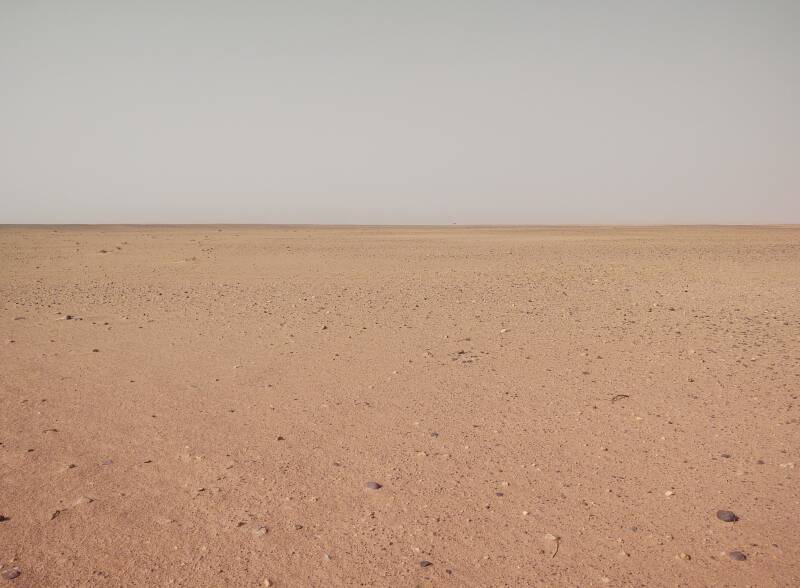
Many people come to Morocco and Western Sahara to look for meteorites.
Spain thought that it wanted Western Sahara, until it became clear that all it has is some of the harshest climate on Earth plus a little phosphate. Well, kind of a lot of phosphate, but not nearly as much as what's found within Morocco.
Spain basically abandoned what they were calling "Spanish Sahara" because they realized that they could get away with fishing along the coast without paying attention to whoever controlled the shoreline territory. And, offshore oil exploration would be done by big corporations regardless, again, of whoever it was that controlled the shoreline. Mauritania thought for a while that they wanted control of the territory, to the point of fighting Morocco for it. But then they, too, walked away from it.
And so, Western Sahara is now the "Southern Provinces" according to Morocco. The U.S. announced in 2020 that they officially would not care about Western Sahara as long as Morocco established diplomatic relations with Israel.
Meanwhile, meteorites. It's not that an unusual number of meteorites happen to strike Earth in southern Morocco and Western Sahara. The distribution of meteorite falls is pretty uniform across the planet.
However, bleak terrain makes them much easier to find. Northwest Africa is the most rewarding place to look for meteorites, with Antarctica second.
We came to a well at 29.8461° N 5.9827° W, about 25 km out of M'Hamid. I thought it was a large well, over 2.5 meters in diameter. Ibrahim provides scale.
The national government dug this well. They bought equipment to dig a vertical shaft deep enough to reach water and enough material to line the shaft with concrete.
The government maintains scattered wells in the more arid areas to support the remaining nomadic people.
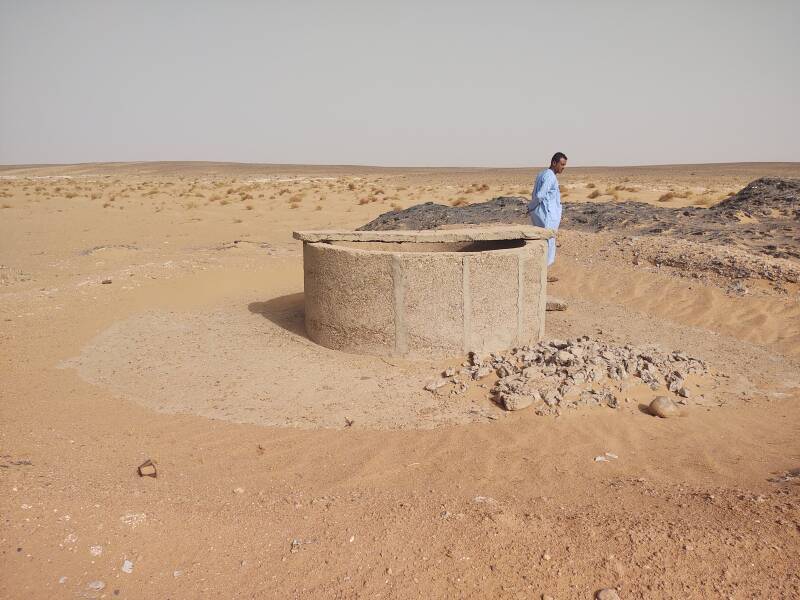
Yes, there's water way down there.
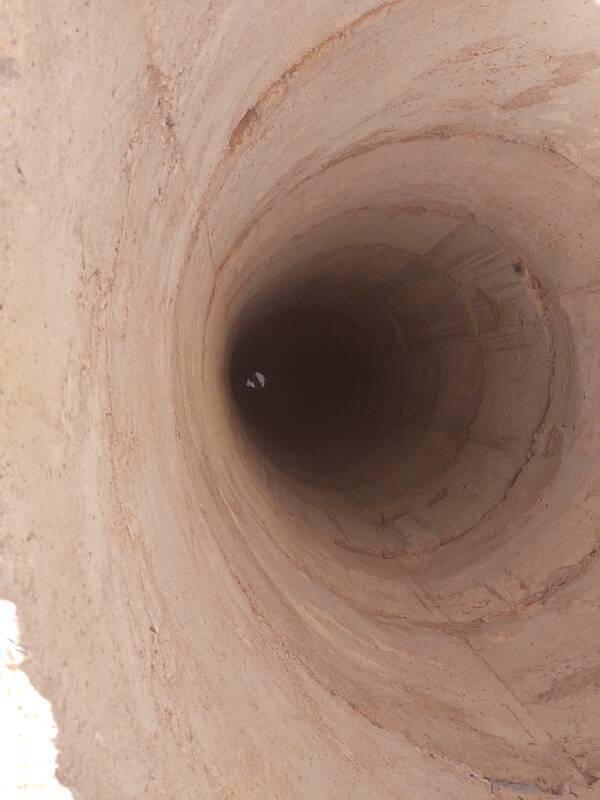
About five kilometers beyond that well we came to the broad el Atach wadi, which runs from north to south to join the Draa.
It's significantly lower than the surrounding terrain, and two to three kilometers wide. The limited vegetation shows that it carries some moisture, but not much. We passed another government-maintained well in the center of the wadi.
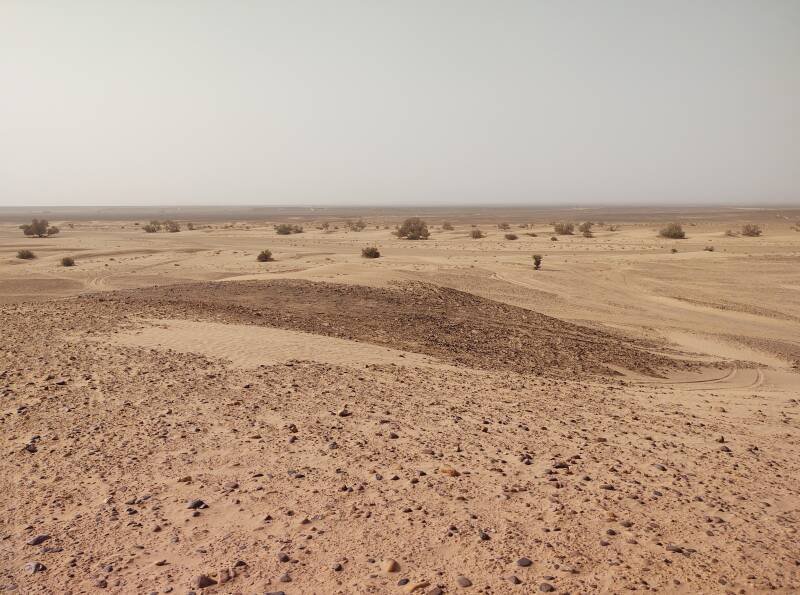
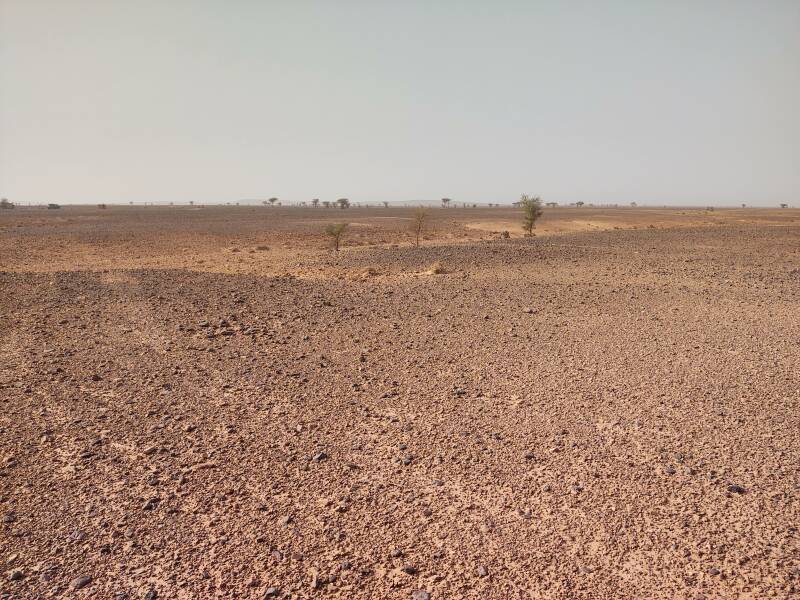
Oum Lâalog is an oasis along the el Miit wadi, at 29.8827° N 6.1184° W. This oasis was a stop on the trans-Saharan caravan route between Zagora and Timbuktu. It has been referred to as L'oasis Sacrée or "The Sacred Oasis of Oum Lâalog" because the spring provides water, the most precious thing in the desert.
The traditional belief is that a fairy or a djinn or some such magical protective being lives here.
Walls enclose an area of about 15 hectares here. An entrepreneur once started building a desert resort, but stopped soon after building the outer wall.
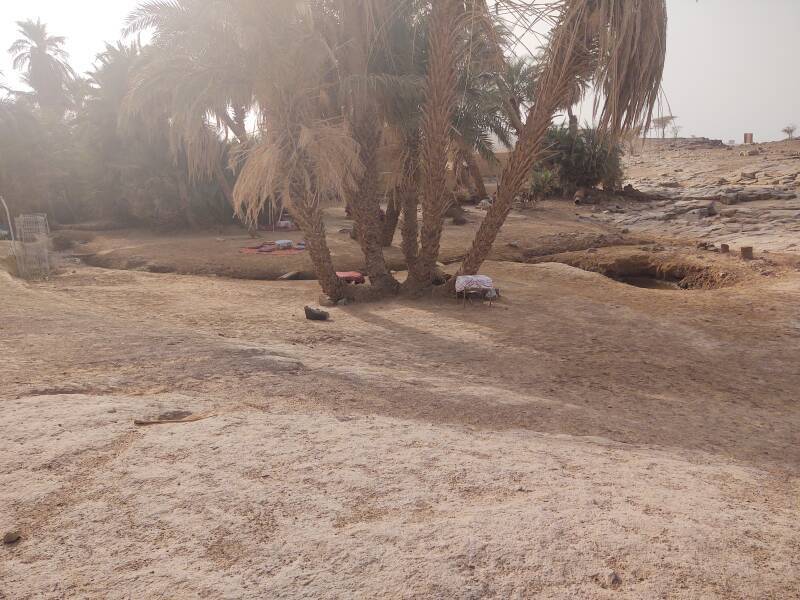
Yes, ripples showed that water was flowing up into this pool.
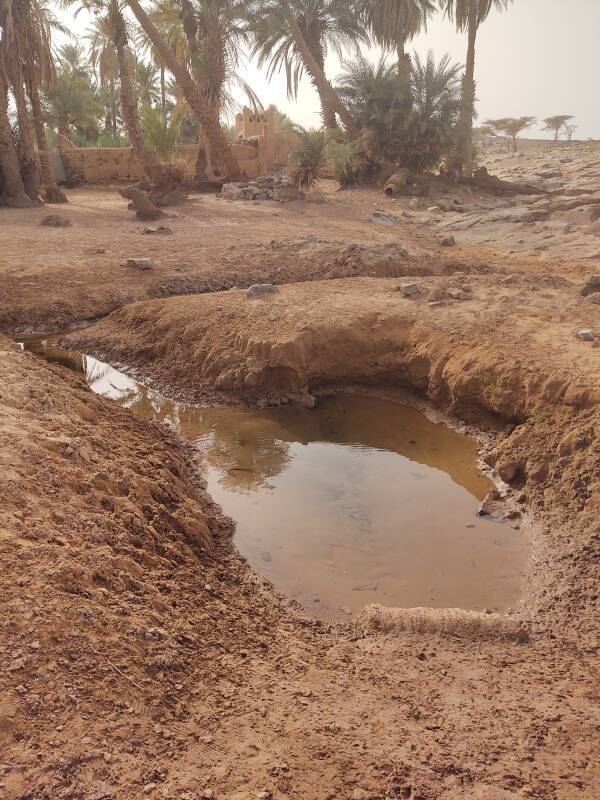
The isolated natural oases like this are endangered for two reasons. First, because of climate change driving increasing aridity. Second, because the oases have been maintained by the nomadic population, and that population is rapidly shrinking.
There is a tea house here, and we had a glass of hot sweet mint tea before continuing.
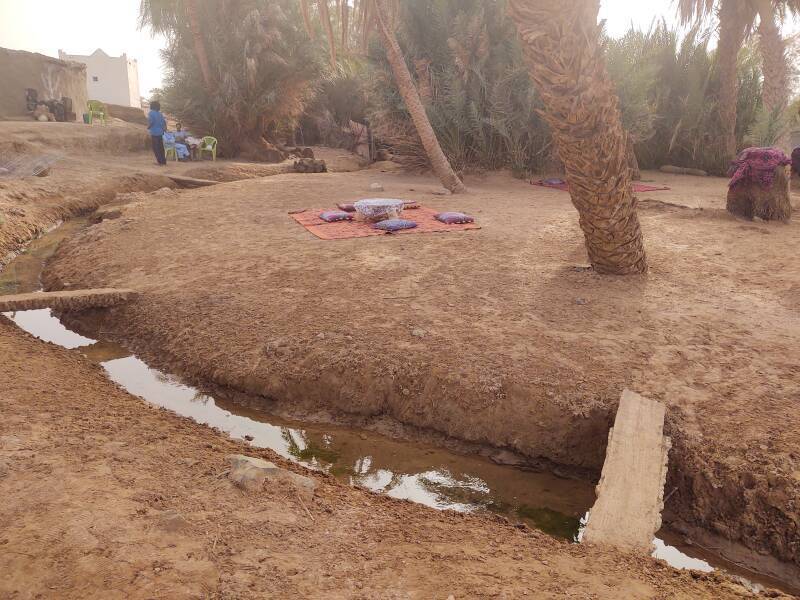
While we were relaxing, someone brought a herd of goats to drink at the spring.
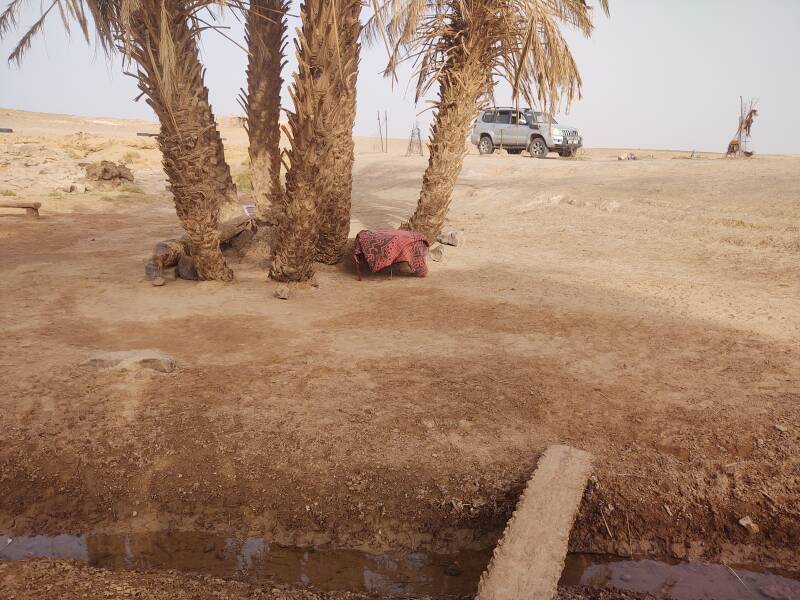
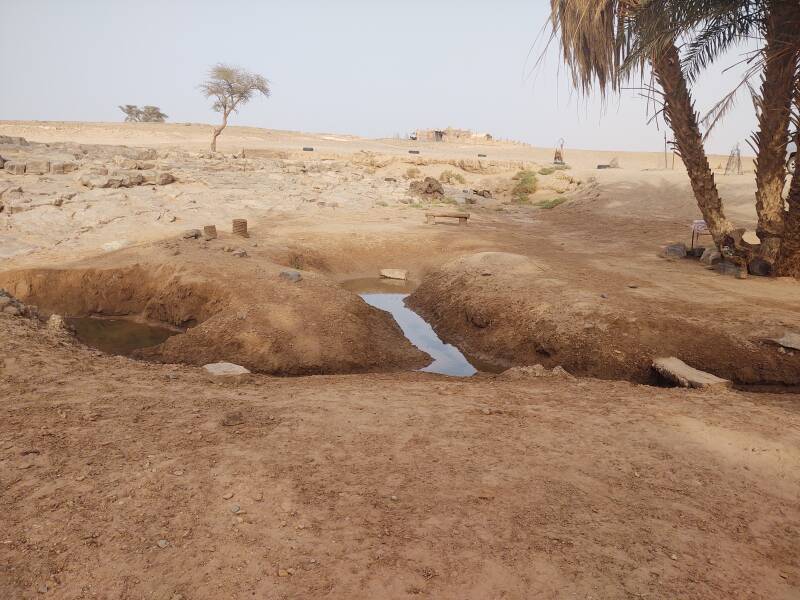
And after your tea, there is a latrine to use before continuing to Erg Chigaga.
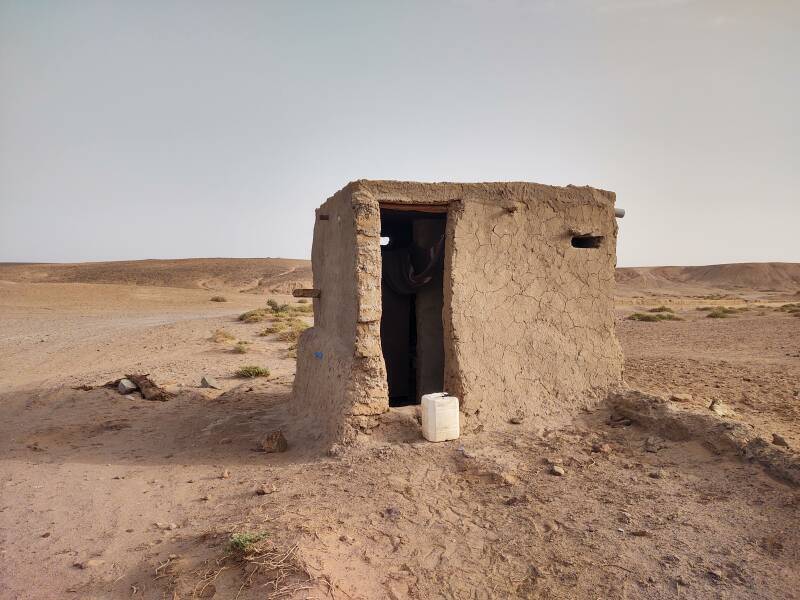
It's a squat facility with no water, unless you use the plastic container seen above to collect some water at the spring.
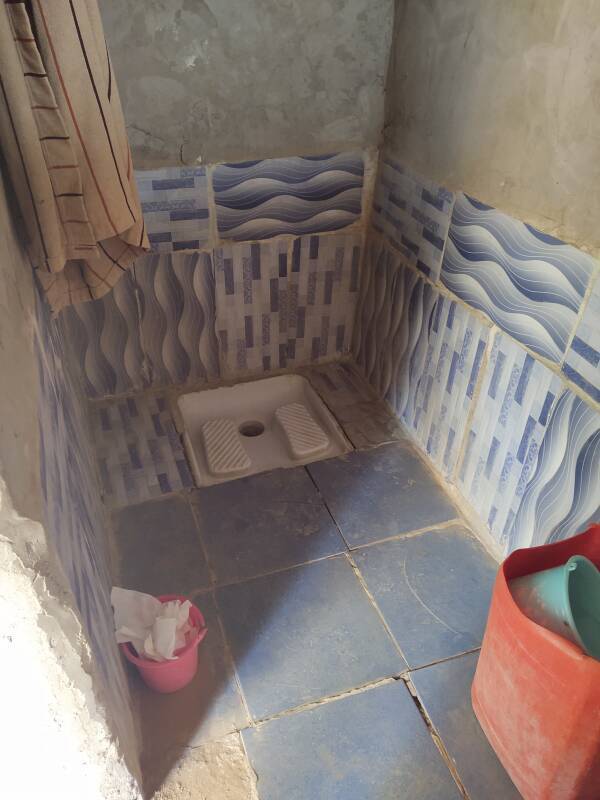
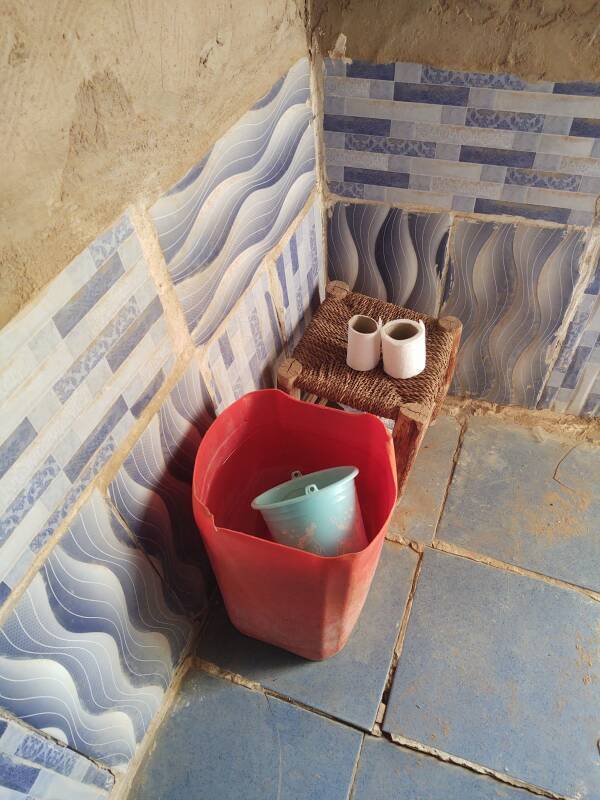
There's much more to see at M'Hamid and in the Sahara, see my general travel page.